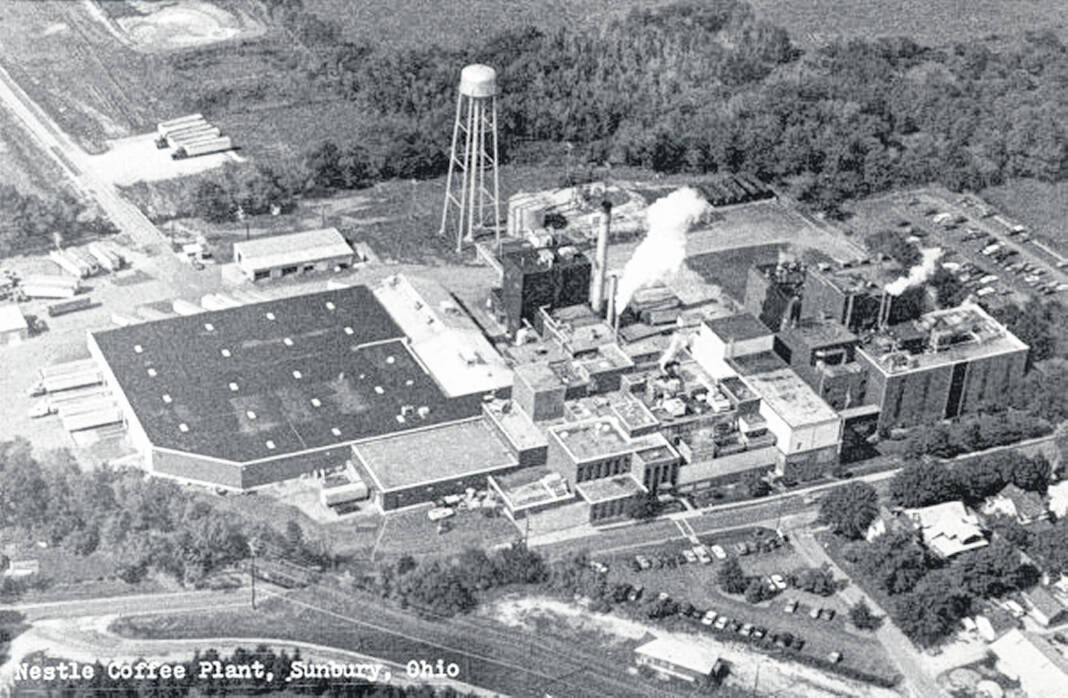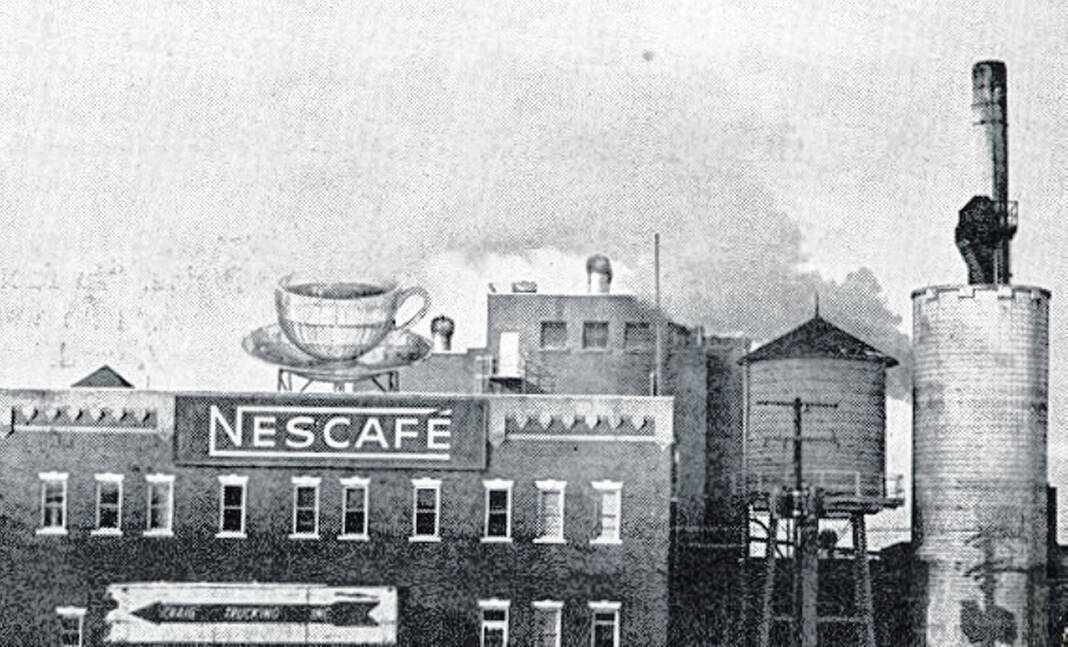

The Big Walnut Area Historical Society (BWAHS) will present a program titled “Sunbury Creamery thru Nestlès” at 1:30 p.m. on Saturday, July 23, in the Myers Inn Museum in Sunbury.
Polly Horn will present the program featuring Jeff Bergandine’s video, documents, and memorabilia of a business which lasted over a century in the community. All former employees and their families are invited to the event. This is the first in-person program being presented by the BWAHS since the COVID-19 pandemic began.
Horn is a native of Sunbury, retired director of Community Library in Sunbury, and curator of the Myers Inn Museum. She grew up with the 8 a.m., 12 p.m. and 5 p.m. Nestlès whistle marking the time of day.
“Loved the constant smell of fresh brewed coffee which surrounded Sunbury for 15 miles, but hated when the fresh laundered white sheets we hung on the line before school had brown stains when we took them down after school. Still can not drink coffee,” Horn said.
Creamery background
Originally, the house wife milked the family cow twice a day and did her best to keep the milk cool in a spring house. She would use the cream to make butter then feed the buttermilk (left after the butter is made) to the pigs. It did tie the person to the homestead.
When Louis Pasteur discovered that when milk is held at a certain temperature for a specified amount of time it kills pathogens in the milk, which in turn makes it last longer and is safer to consume, it changed the process so a farmer could sell milk, cream and butter.
Soon, people began to build creameries in their own communities so farmers could take care of and milk the cows then take milk or cream to the creameries for processing. Creameries around the area all looked very much alike with a long porch roof over a door at wagon height. The farmer drove under the roof so the milk in cans was unloaded from the wagon into the creamery.
Sunbury Co-Operative Creamery founded
In 1882, a group of forward-thinking men decided to form a corporation for the purpose of making milk products. They would buy the cream from the farmers and sell the leftover milk back to the farmers to slop their hogs. Sunbury Co-Operative Creamery was organized and incorporated for $6,000 with shares selling at $100 per share. The original directors were farmers and businessmen: Jasper Boyd, Joseph Kimball, Tom Andrews, O.H. Kimball, W.P. Roberts, John Landon and Kimball Sedgwick.
Joseph Kimball was the first manager, and the incorporation document is on display in Myers Inn Museum.
Sunbury Co-Operative Creamery took over the stations in Center Village, Kilbourne, Cheshire, Marengo and Condit. Cheshire took in 12,000 pounds of milk per day and Marengo took in 6,000. Each of the others received 20,000 pounds of milk daily.
Cream was separated at the stations and the skimmed milk returned to the farmers to feed to their pigs. The cream was taken by horse and wagon to the Sunbury plant where it was made into butter and cheese. The Sunbury plant made 500 pounds of butter each day, which sold for 25 cents a pound.
In 1903, a cow made of Sunbury butter won a sculpture contest at the Ohio State Fair, so the butter was renamed Sunbury Famous Butter and shipped in refrigerated boxcars from the railroad station to New York and California.
Farmers were paid 5 cents a pound for their butterfat once a month. Garfield Chadwick, accountant for the co-op, and Clarence Geddis would meet with Farmers Bank Manager Charles Armstrong, who was also treasurer of the co-op, after the bank closed, and they would figure how much each farmer had earned and put his money in gold in an envelope. The next day, Geddis and Chadwick would drive around to all the stations and deliver the money — a trip that took at least four days. In 1966, Geddis told The Sunbury News editor, Bill Whitney, “We never had any trouble or holdups.”
In 1918, the creamery was sold to John Wildi Evaporated Milk Company for $25,000. The sale included the buildings and equipment in Sunbury, Condit, Kilbourne and Cheshire. Evaporated milk and cheese were the big products.
Nestlès comes to town
A year later in 1919, the company consolidated with Nestlé Alimentania, S.A.
In 1865 in Vevey, Switzerland, Henri Nestle had been working on a baby food product when an infant in the town was born with no tolerance to breast milk or existing milk products. It was decided to give Henri’s invention a try because the boy would surely die otherwise. The baby not only survived, he appeared to be very normal in every way. Word of such a miracle spread rapidly. In 1868, the medical profession had approved the baby food product and production began in Switzerland. Thus started the worldwide company which came to Sunbury.
In 1924, Nestlés brought Ernest Fivaz and his family, of Vevey, Switzerland, to Sunbury from Fulton, N. Y., to supervise the making of baby formula. He carried the top secret formula in his head. The Fivaz family soon put down roots in Sunbury. Mr. Fivaz was honored for 40 years of service to Nestlés in 1940, the late Annette Roberts was the last of the seven Fivaz children living in Sunbury.
In a small corner of the baby food manufacturing plant, a handful began to turn out an instant coffee called Nescafe. Although much of the research happened elsewhere, in 1939, before convenience foods were popular, Sunbury produced 350 pounds of instant coffee an hour. In 1943, the company received the Army-Navy E Award for high achievement in producing Nescafe for every serviceman’s ration pack. The pleasant aroma of brewed coffee covered the area and resulted in more than one person stopping in the town to inquire about its source. The cup on top of the plant with the steam coming up from behind it became a Sunbury trademark.
The Sunbury plant was the first to produce instant tea, Nestea, in 1946. In 1968, Sunbury added the first continuous freeze drying process and added Taster’s Choice to the coffee line. This became the primary product from Sunbury.
In 1981, a five-story addition for a natural decaffeination plant was added at a cost of $27 million. Daily, the plant removed 2,500 pounds of caffeine from a million pounds of coffee beans and sold it to Coca-Cola for use in soft drinks. Caffeine became the new primary product for this plant, but decaffeinated coffee was not so popular.
Nestlés and Hills Company merged in May 1991 and became the Nestlés/Hills Brothers Coffee Company and then Nestle Beverage Company. It was announced in 1993 the Sunbury plant would close.
When production ceased, Nestlés was responsible for 32% of the village income tax, 40% of the water fees, and owned 250 acres of land.
Colin Swift, plant manager, worked hard to help his dedicated employees find new jobs.
Jeff Bergandine (son of Frank Bergandine, longtime plant manager) and his mother, Verna, made a VHS about plant, whichwill be shown during the July 23 program.
Myers Inn Museum is located at 45 S. Columbus St. in Sunbury. It is open 10 a.m. to 3 p.m. on Saturdays and by appointment. For more information, call 740-965-3582 or visit bigwalnuthistory.org.



